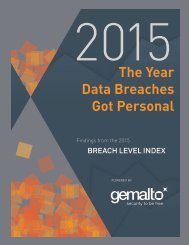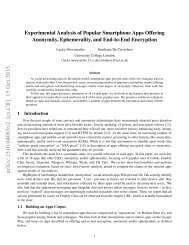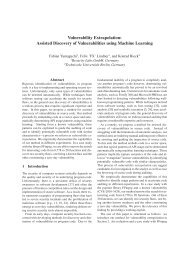Deobfuscating Embedded Malware using Probable-Plaintext Attacks
Deobfuscating Embedded Malware using Probable-Plaintext Attacks
Deobfuscating Embedded Malware using Probable-Plaintext Attacks
Create successful ePaper yourself
Turn your PDF publications into a flip-book with our unique Google optimized e-Paper software.
14 <strong>Deobfuscating</strong> <strong>Embedded</strong> <strong>Malware</strong> <strong>using</strong> <strong>Probable</strong>-<strong>Plaintext</strong> <strong>Attacks</strong><br />
Deobfuscation rate in percent<br />
100<br />
80<br />
60<br />
40<br />
20<br />
Kandi (r = 1.0)<br />
0<br />
0 2 4 6 8 10 12 14 16<br />
Key length<br />
(a) Obfuscated PE files<br />
Deobfuscation rate in percent<br />
100<br />
90<br />
80<br />
70<br />
60<br />
50<br />
40<br />
r = 0.0<br />
r = 0.5<br />
r = 1.0<br />
4 5 6 7 8<br />
Key length<br />
(b) Influence of the overlap ratio<br />
Fig. 7. Deobfuscation performance of Kandi on Word documents containing obfuscated<br />
PE files. Figure (b) shows the performance for different overlap ratios.<br />
4.2 Real-World Experiments<br />
To top off our evaluation we proceed to demonstrate how Kandi is able to<br />
deobfuscate and extract malware from samples seen in the wild. To this end, we<br />
have acquired four datasets of real-world malware embedded in documents and<br />
images with different characteristics.<br />
Table 2. Overview of the four datasets of malicious documents and images.<br />
Dataset name Type Formats Samples<br />
Exploits 1 Documents DOC, PPT, RTF 992<br />
Exploits 2 Documents DOC, PPT, RTF 237<br />
Dropper 1 Documents DOC, PPT, RTF 336<br />
Dropper 2 Images PNG, GIF, JPG, BMP 52<br />
Total 1,617<br />
<strong>Malware</strong> Datasets. <strong>Embedded</strong> malware is typically executed by exploiting<br />
vulnerabilities in document viewers. For the first dataset (Exploits 1 ) we thus<br />
retrieve all available Word, Powerpoint and RTF documents from VirusTotal<br />
that are detected by an anti-virus scanner and whose label indicates the presence<br />
of an exploit, such as exploit.msword or exploit.ole2. Similarly, we construct<br />
the second dataset (Exploits 2 ) by downloading all documents that are tagged<br />
with one of the following CVE numbers: 2003-0820, 2006-2492, 2010-3333,<br />
2011-0611, 2012-0158 and 2013-0634.<br />
As our method specifically targets PE files embedded in documents, we additionally<br />
compose two datasets of malware droppers. The first set (Dropper 1 )<br />
contains all available Word, Powerpoint and RTF documents that are detected<br />
by an anti-virus scanner and whose label contains the term dropper. The second<br />
dataset (Dropper 2 ) is constructed similarly by retrieving all malicious images









